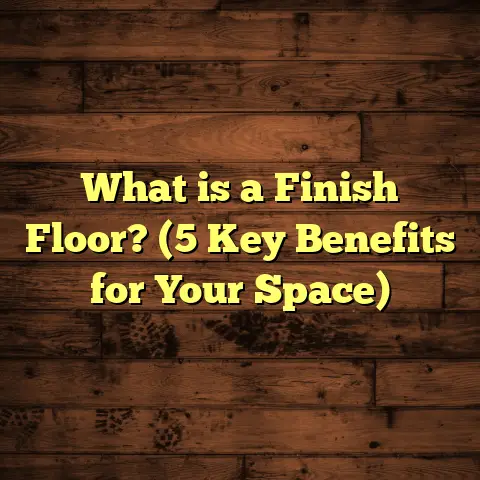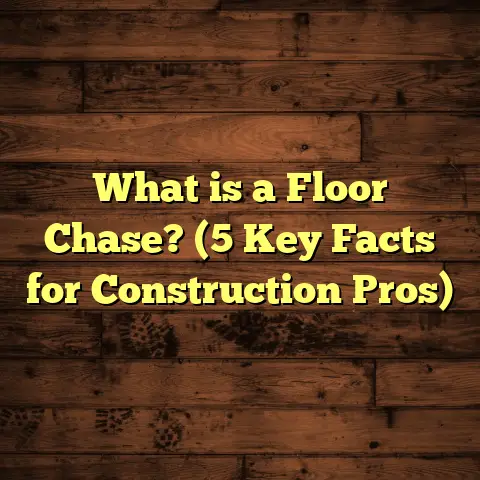What is a Flagstone Floor? (5 Benefits & Design Ideas Revealed)
What Is a Flagstone Floor?
Have you ever noticed how some floors have that natural, timeless feel? Like when you step outside onto a stone path or a patio and it just feels… authentic? That’s often because it’s flagstone. But what exactly is a flagstone floor? Why does it stand out compared to other flooring options? And is it something you could see working in your space?
Flagstone flooring is made from natural stone slabs that are cut or split into relatively flat, thin pieces. These pieces are usually irregular in shape and size and laid out in patterns with the gaps filled by mortar, sand, or sometimes left open for a rustic look. The stones themselves typically come from sedimentary rocks—sandstone being the most common—but can also include limestone, slate, or quartzite depending on where it’s quarried.
When I first worked with flagstone, I was struck by how unlike any manufactured flooring it felt. There was an immediate connection to nature. The texture beneath my feet was uneven but not uncomfortable. The colors weren’t uniform or washed out—they had depth and character. That experience changed how I think about flooring design entirely.
Origins and Natural Beauty of Flagstone
To appreciate flagstone fully, it helps to understand its origins. The term “flagstone” dates back to Old Norse “flaga,” meaning a slab or chip of stone. For centuries, people around the world have used flat stones for building and paving because of their durability and availability.
In the U.S., flagstone is often quarried in places like Pennsylvania, Arizona, and Colorado. Each region produces stone with distinct colors and textures due to the mineral content and geological history. For example:
- Pennsylvania flagstone tends to be blue-gray.
- Arizona flagstone often has warm reds and browns.
- Colorado flagstone can range from earthy browns to soft tans.
These regional differences allow you to select stone that complements your home’s style and setting. When I helped a client near the Rocky Mountains pick their stone, we chose Colorado quartzite for its hardness and sparkling texture. It perfectly matched their mountain home’s rustic yet elegant vibe.
5 Benefits of Flagstone Flooring
From my years of working with various flooring materials, flagstone floors bring some unique advantages that stand out. Let me share five major benefits I consistently see clients appreciate.
1. Rock-Solid Durability
Flagstone is literally rock-solid. These stones have been formed over millions of years under pressure, making them incredibly tough.
Whether indoors or outdoors, flagstone resists wear and tear better than many other materials like hardwood or ceramic tile. It handles heavy foot traffic without showing scratches or dents.
One of my clients installed flagstone in a busy family mudroom where kids come in with shoes and sports gear daily. After three years, the floor still looked intact with no chipping or cracking.
Data point: The Natural Stone Institute reports that properly installed flagstone floors last 50+ years with minimal maintenance.
Plus, flagstone’s natural thickness and density make it resistant to temperature changes and moisture damage — perfect for climates with freeze-thaw cycles.
2. One-of-a-Kind Aesthetic
No two flagstones look alike. Each slab has unique color variations, veins, and textures that create an organic mosaic effect.
This uniqueness adds warmth and natural beauty you don’t get with uniform tiles or vinyl.
During one project, I helped a homeowner design a sunroom floor with flagstone slabs arranged loosely to mimic the garden outside. The irregular shapes and earth tones blurred the boundary between indoors and outdoors.
The variety in colors—ranging from rust reds, golden yellows, deep grays to soft blues—allows for personalized style. You can emphasize rustic charm or create a more modern space depending on the stone choice and layout.
3. Incredible Design Versatility
Flagstone fits almost any design style. You can use it indoors or outside; in casual patios or formal foyers.
The irregular shapes lend themselves well to random patterns that feel natural and relaxed.
Or you can cut slabs into rectangles or squares to achieve geometric patterns for a more polished look.
I once installed a herringbone pattern inside a rustic cabin using slate flagstones—a style typically reserved for wood floors—and it brought sophistication without losing natural appeal.
Also, mixing flagstone with other materials like wood trims, pebbles, or even metal accents creates stunning contrasts that catch the eye.
4. Low Maintenance
Compared to hardwood or tile which often require special cleaning products or refinishing, flagstone is easier to care for.
Outdoors, a simple sweep or garden hose rinse usually keeps it clean. Indoors, mopping with mild soap works well.
Sealing every few years helps protect against stains and moisture but isn’t mandatory depending on your stone type and location.
A client of mine who installed flagstone in their bathroom told me they only mop once a week with gentle cleaner and never had any issues with mold or discoloration.
5. Eco-Friendly Flooring Option
Choosing natural stone like flagstone can be good for the environment—especially if quarried locally.
Unlike synthetic flooring which requires chemical processing and petroleum-based raw materials, flagstone involves minimal processing beyond cutting and splitting.
Plus, its durability means less frequent replacement compared to materials like carpet or vinyl that wear out faster.
Using stone from nearby quarries also reduces transportation emissions.
In one project near Pennsylvania, we sourced local sandstone within 50 miles of the site—cutting down costs and environmental impact simultaneously.
My Personal Tips for Getting the Best Out of Flagstone Floors
Having installed dozens of flagstone floors myself and consulted on countless projects, I want to share practical advice not always found in DIY guides.
Picking the Right Stone for Your Project
Not all flagstones are created equal. Here’s what I consider:
- Sandstone: Great for patios because it’s slip-resistant with warm earthy tones.
- Slate: Darker colors; good indoors due to smooth surface but can be slippery wet.
- Limestone: Softer but elegant; better for low traffic areas.
- Quartzite: Hardest option; sparkly texture; ideal for high traffic zones and outdoor kitchens.
Ask yourself where you want to use it: indoors or outdoors? High traffic or decorative?
For example, sandstone works beautifully for walkways but might crumble faster indoors if used in wet areas without sealing.
Preparing Your Base Is Key
Flagstones need a solid foundation to prevent cracking or shifting over time.
For outdoor installations:
- Excavate soil down to stable ground.
- Add layers of gravel for drainage.
- Use sand or mortar bed to level stones.
Indoors:
- Subfloor should be clean, flat, and strong enough to support heavy stone weight.
- Sometimes plywood alone won’t cut it—you might need reinforced concrete slab depending on thickness.
In one job in Florida’s humid climate, insufficient base prep caused stones to loosen after heavy rains. Re-doing the base was costly but necessary.
Pattern Choices Make All the Difference
Patterns affect not just aesthetics but installation complexity and cost.
- Random pattern: Most natural-looking but requires skillful fitting.
- Rectangular pattern: More uniform; easier installation.
- Herringbone or basket weave: Adds visual interest but can be pricier due to cutting precision.
Think about how much time/money you want to invest versus your design vision.
Sealing Your Flagstone Floor
Sealing isn’t always needed but recommended if:
- You expect stains (like kitchens/bathrooms).
- You live in rainy climates.
- You want enhanced color depth.
Choose breathable sealers made specifically for natural stone. Avoid sealers that trap moisture underneath—they cause damage over time.
Before sealing whole floor, test on a small hidden slab section. Some sealers darken lighter stones more than others.
Case Study: Backyard Flagstone Patio Makeover
Allow me to share a detailed project story showing how flagstone transforms spaces:
A couple wanted their backyard patio redone into an inviting place for entertaining friends around a fire pit.
We chose Arizona sandstone because of its warm rust tones matching autumn foliage nearby.
The design was freeform random pattern to embrace organic flow rather than rigid shapes.
Installation took about two weeks due to careful fitting of irregular shapes—like solving a giant jigsaw puzzle!
We laid down gravel base before setting each slab on a sand bed ensuring proper drainage and stability.
Clients were thrilled with how the patio blended with their landscaping—feeling like an extension of nature itself.
They also appreciated using FloorTally software early on for accurate budgeting of materials and labor which helped avoid surprises later on.
More Flagstone Floor Design Ideas
Need inspiration? Here are five design ideas I personally love:
1. Rustic Indoor Kitchen Floors
Large slabs with wider joints filled using grout matching cabinets create cozy vibe.
Add warm lighting highlighting stone textures which accentuates their natural beauty even more during evening meals.
2. Outdoor Patio Oasis
Pair flagstone slabs with wooden decking or metal furniture for contrast between rough stone and sleek surfaces.
Plant creeping vines or moss growing between stones for lush garden feel underfoot.
3. Spa-Like Bathroom Floors
Slate flagstones work wonderfully here due to their water resistance and smooth surface.
Pair with bamboo accessories and pebble mats for zen atmosphere.
4. Fireplace Hearth Statement
Thick flagstones around hearth create rugged charm that contrasts nicely against polished mantlepieces or modern furniture nearby.
5. Inviting Garden Walkways
Irregular stones laid randomly invite visitors into your garden naturally without feeling too “man-made”.
Flagstone Flooring Compared to Other Popular Flooring Materials
If you’re weighing options, here’s how flagstone stacks up:
| Flooring Type | Durability | Maintenance | Cost per sq.ft* | Aesthetic Appeal | Eco-Friendliness |
|---|---|---|---|---|---|
| Flagstone | Very High | Low | $15-$25 | Natural, unique | High (natural stone) |
| Hardwood | Medium-High | Moderate | $8-$15 | Classic warmth | Medium (wood source) |
| Laminate | Medium | Low | $2-$6 | Imitates wood/stone | Low (synthetic) |
| Ceramic Tile | High | Moderate | $5-$10 | Wide style options | Medium (clay source) |
| Vinyl | Low-Medium | Low | $2-$7 | Many styles | Low (synthetic) |
| Carpet | Low | High | $3-$7 | Soft feel | Low |
*Prices are approximate US averages (2024)
Flagstone’s higher upfront cost is balanced by its longevity and minimal upkeep needs. Plus, its aesthetic richness is hard to match by man-made options.
Caring for Your Flagstone Floor: Maintenance Tips
Want your floor looking great for decades? Here’s what I recommend:
- Sweep regularly indoors/outdoors to prevent grit buildup scratching surface.
- Mop indoors with mild soap; avoid acidic cleaners like vinegar which can etch stone.
- For outdoor floors, rinse off dirt after storms.
- Seal every few years if exposed to stains/water.
- Repair chips/cracks promptly using stone filler kits available at hardware stores.
- Avoid dropping heavy objects—though it’s tough stone, anything brittle can chip if hit hard enough.
One client told me how their sealed sandstone patio stayed stain-free despite kids spilling wine and barbecue sauce during parties — just rinsed off with water!
Frequently Asked Questions About Flagstone Flooring
Here are some common questions I get asked:
Will Flagstone Floor Be Slippery When Wet?
It depends on stone type and finish. Sandstone is naturally textured so less slippery outdoors; slate can be slick indoors if polished. Adding anti-slip sealers helps too.
How Long Does Installation Take?
For typical patios or indoor rooms (300-500 sq.ft), expect about 1-3 weeks including base prep, laying stones, grouting/sealing—depends on complexity of pattern and site conditions.
Can Flagstone Be Used in Kitchens?
Absolutely! It’s durable enough for kitchens but consider sealing well against food stains/oils. Softer stones like limestone might need extra care here.
Is Flagstone Expensive?
It costs more upfront than laminate or vinyl but lasts decades longer so overall value is good. Budget $15-$25 per sq.ft including installation for good quality stone floors in US markets today (2024).
Wrapping Up My Thoughts on Flagstone Flooring
Flagstone floors aren’t just about looks; they offer strength, individuality, low upkeep, and eco-friendliness all wrapped in one package. Their natural textures create spaces that feel connected to nature in ways synthetic materials can’t match.
If you want floors that tell a story—crafted by earth over millennia—and grow more beautiful with age, flagstone is well worth thinking about seriously.
What kind of space do you have? Are you drawn more to indoors cozy warmth or rugged outdoor charm? Feel free to ask me anything about selecting, installing, maintaining flagstone floors—I’d love to help you bring that natural beauty into your home!
If you want me to add specific sections like step-by-step installation process details or cost breakdowns using FloorTally data or more case studies from different regions, just say so!





